It’s hard not to like cartridges with names like Swift, Hornet and Fireball. Here’s what they do best in the field.
Photo: The .22-250 Rem and .220 Swift have the reach when shots are long.
There really are only a few popular .22-caliber centerfire cartridges, and each one covers only a certain range of bullet velocities. That makes trying to find one cartridge to cover all .22 centerfire shooting a challenge. My solution is to choose the fastest and most popular cartridge and tailor its handloads to fit the shooting situation.
Let’s look at the established .22-caliber cartridges to see how they measure up.
.22 Hornet
The .22 Hornet is the king of economical shooting. But its old-fashioned case design with a sloping shoulder is a pain to handload. If a bullet is inserted crooked into a Hornet’s case mouth, chances are the shoulder will crumple when the bullet is seated.
Also, most Hornet rifles like the Ruger 77/22 have a short magazine that limits cartridge length. Only blunt-nosed can be used in them. However, a single-shot rifle like the Cooper Firearms Model 38 readily accepts sharply pointed bullets.
 But enough about the Hornet’s negatives.
But enough about the Hornet’s negatives.
The Cooper Arms Model 38 Varminter in .22 Hornet I’ve been shooting burns only 10 to 12 grains of powder to push a 40-grain bullet at up to 2,800 feet per second. With the rifle sighted about an inch high at 100 yards, I can hold on the eye of a prairie dog and hit the little varmint out to 200 yards. That absence of recoil and trajectory results in a lot of fun in the field. However, there is a better choice for a mild varmint cartridge.
.221 Remington Fireball
I’m going with the .221 Fireball for economical shooting and high velocity for the amount of powder burned. The Fireball cartridge is essentially a .223 Remington with a shorter body. The Fireball was developed for Remington’s XP-100 bolt-action handgun with a 10.75-inch barrel. From that barrel length, a 50-grain bullet reaches only about 2,600 fps. But bullet speeds increase at least 400 fps with a 24-inch barrel.
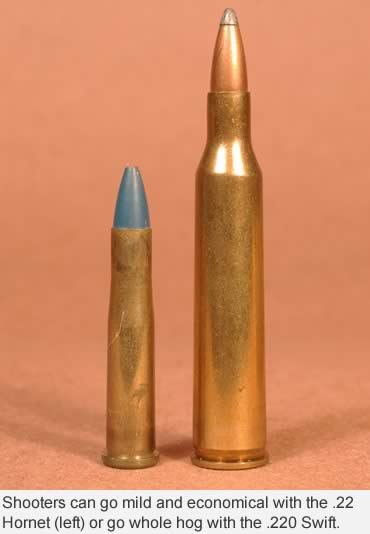 A friend loads his Fireball with 16.0 grains of Lil’Gun powder to push 40-grain Nosler Ballistic Tips out the muzzle of his Remington Model 700 at 3,400 fps. He says that load shoots flat enough that he can aim right on as far as he has any chance of hitting ground squirrels. The standard contour barrel on his Remington stays fairly cool during a long string of shots, too.
A friend loads his Fireball with 16.0 grains of Lil’Gun powder to push 40-grain Nosler Ballistic Tips out the muzzle of his Remington Model 700 at 3,400 fps. He says that load shoots flat enough that he can aim right on as far as he has any chance of hitting ground squirrels. The standard contour barrel on his Remington stays fairly cool during a long string of shots, too.
I’ve been shooting a .221 based on a Surgeon 591 short-action single-shot, and it has been turning in some impressive velocities. Nosler 35-grain Ballistic Tip Lead-Free bullets shoot up to 3,700 fps, and Berger 40-grain bullets up to 3,500 fps.
Velocities really start to drop off with heavier bullets. Top end with 50-grain bullets is about 3,000 fps and 2,900 fps with 55-grain bullets.
The recoil of these loads barely bumps the crosshairs off the target. Varmint hunters like that because they get see the terminal result of their bullets. How accurate was the Fireball in the Surgeon action? I figured I had a bad case of the shakes if some of the better loads failed to group five bullets in .3 to .6 of an inch at 100 yards.
The lack of rifle choices is the only problem with the Fireball. Remington dropped its Model 700 a few years ago. The CZ 527 American bolt-action and the Cooper Firearms Model 38 single-shot are the only rifles currently chambered in .221 by major manufacturers.
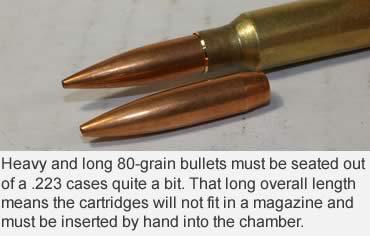 .223 Remington
.223 Remington
The .223 Remington is by far the most popular .22-caliber centerfire, and perhaps the most popular cartridge in America. This military cartridge in civilian dress is chambered in plain-Jane break-action single-shots to bolt-actions and of course autoloaders. Lots of autoloaders.
The .223’s standard 1-in-12-inch twist works well with bullets weighing 40 to 63 grains. My Remington Model 700 SPS has that twist and shoots that range of bullet weights well.
For ground squirrels and prairie dogs, I prefer a Nosler 40-grain Ballistic tip at slightly over 3,600 fps. For larger game like coyotes, I use a Sierra 50-grain BlitzKing at 3,386 fps.
But say I want to buck the wind on some long-distance shots. That 1-in-12 twist will not stabilize long and sleek bullets like the Sierra 69-grain hollowpoint boat tail.
That same twist in my Savage Predator Hunter .223 shoots those heavy bullets accurately. The Sierra 69-grain MatchKing bullets have a muzzle velocity of 2,903 fps with 26.5 grains of N540 propellant from the Savage’s 22-inch barrel. Groups with that load were .66 inch at 100 yards, 1.08 inches at 300 yards, 3.30 inches at 400 yards and 4.00 inches at 500 yards.
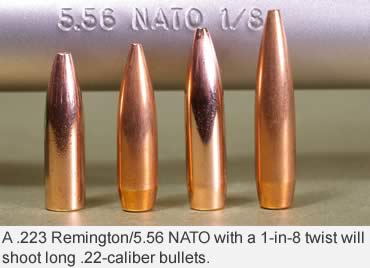 The Savage also shoots lighter bullets accurately, too, as in five 40-grain bullets inside half an inch at 100 yards. So despite what life coaches tell us, we can have it all.
The Savage also shoots lighter bullets accurately, too, as in five 40-grain bullets inside half an inch at 100 yards. So despite what life coaches tell us, we can have it all.
A Smith & Wesson M&P PC I’ve been testing has an even faster twist of 1 in 8. The gun also shoots 35- to 80-grain bullets well.
Some of the older thin-jacketed bullets cannot withstand the rotational force imparted to them by such a sharp rifling twist. A few of the Hornady Super Explosive 50-grain bullets I shot from the M&P shredded into a lead mist in front of the muzzle.
A better choice is the Hornady V-Max or Sierra BlitzKing that can hold up to about any speed or twist rate.
It’s difficult to dismiss the .223 Rem as the best .22-caliber centerfire cartridge. What’s not to like about a cartridge that burns only 20-some grains of powder to produce high velocities?
An even faster round is required when coyotes and marmots thumb their tails at 400 yards and farther.
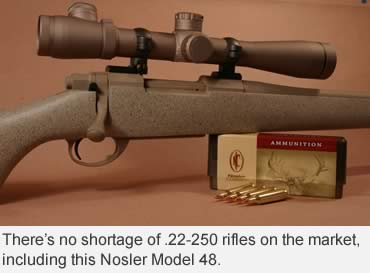 .220 Swift
.220 Swift
You have to like a cartridge with the name Swift. And with such a name, it has to be the king of velocity.
My Winchester Model 70 Varmint Swift with a 26-inch barrel clocks 100 or more fps faster than the speediest loads from my .22-250s. Those Swift velocities could be increased a bit more, but I’m babying the bore on the old rifle.
The Swift shoots Sierra 40-grain BlitzKings at 4,200 fps and Sierra 50 BlitzKings at more than 4,000 fps.
A sleek 55-grain bullet is probably the best for long-range shots. The Combined Technology 55-grain Ballistic Silvertip flies 3,706 fps from my Swift with 44.3 grains of Hunter powder.
I haven’t tried the combination yet, but 41.0 grains of Alliant’s new Power Pro 2000MR shoots Hornady 55-grain V-MAX bullets at 3,920 fps. Nothing in the .22-caliber kingdom with that bullet weight is faster.
The Swift is rough on cases. They stretch quite a bit on firing and resizing. Some of my case necks have split after five firings.
The Swift’s high pressure also supposedly causes brass to flow forward, increasing neck thickness. I’ve never seen that. To be sure, I measured case necks before and after firing, and the measurements were the same.
The only problem with the Swift is that it’s almost at the end of its reign. The only new rifles chambered for it are the Remington Model 700 Varmint Stainless Fluted and the Cooper Firearms Model 22.
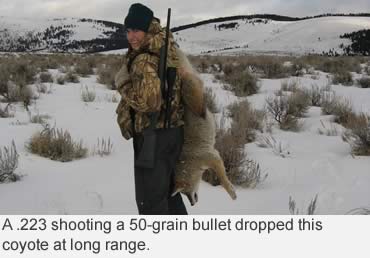 .22-250 Remington
.22-250 Remington
Unlike the Swift, .22-250 rifles are widely available. Remington, for instance, offers seven versions of its Model 700 in .22-250 alone.
Savage has even more options, chambering 37 of its bolt action variations in .22-250.
Whether it’s loaded fast for long shots or loaded down to duplicate velocities of the .223, .221 or .22 Hornet, the .22-250 is always a good choice.
Factory loads launch 40-grain bullets at slightly over 4,000 fps and 55-grain bullets at 3,600 fps. Handloads increase that velocity by about 100 fps.
My favorite long-range load is the Sierra 55-grain BlitzKing with 36.0 grains of IMR 303. Velocity is 3,654 fps from the 24-inch barrel of a Cooper Model 22. With the BlitzKing hitting 2.5 inches high at 100 yards, it’s right on at 300 yards and 9 inches low at 400. That means I can hold on the nose of a rockchuck way out there and hit it.
To save nickles on powder and decrease recoil, I also shoot reduced velocity loads in the .22-250 when the shots are shorter. To duplicate the .223, I just load a minimum amount of standard powders in the .22-250.
For example the Sierra 63-grain bullet travels 3,132 fps with 35.0 grains of Big Game powder. That load is very accurate, too.
Other loads that duplicate the .223 are the Nosler 40-grain Ballistic Tip with 33.0 grains of H4895 for a speed of 3,574 fps, and 33.0 grains of W748 with the Hornady 55-grain SP bullet at 3,266 fps. Those powder weights are only about 5 grains more than the .223 shoots.
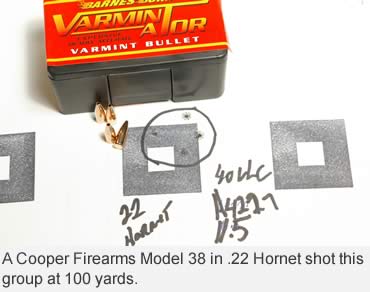 The .22-250 closely replicates the .221 Fireball with Nosler 50-grain Ballistic Tips at 3,261 fps with 35.0 grains of W748.
The .22-250 closely replicates the .221 Fireball with Nosler 50-grain Ballistic Tips at 3,261 fps with 35.0 grains of W748.
The .22-250 can also be turned into a mild .22 Hornet. Nosler 40-grain Ballistic Tip travels 3,199 fps with 33.0 grains of IMR 3031. Hornady 40-grain V-MAX trots along at 3,050 fps from 25.0 grains of H4198.
Even slower is the 40-grain bullet at 2,606 fps with 17.0 grains of H4198. The heavier 55-grain Hornady SP bullet lumbers downrange at 2,844 fps with 23.0 grains of H4198.
With some creativity at the loading bench, a hunter with one .22-250 can take on the longest shots at predators and marmots. Then by merely switching loads, he duplicates all the smaller .22-caliber cartridges, all in one rifle. This makes the .22-250 is the most versatile .22-caliber cartridge.
Read Recent GunHunter Articles:
• The Hunter’s Telescope: There is no magic in a spotting scope; it just looks that way.
• Chronograph Reliability: Many variables can affect velocity readings. Here’s how to set up for best results.
This article was first printed in the September 2011 edition of Buckmasters GunHunter Magazine. Subscribe today to have GunHunter delivered to your home.